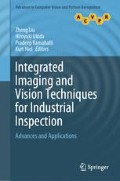Abstract
In this chapter, we describe an industrial inspection system composed by a 3D vision system, mounted on a manipulator robot arm, able to perform quality and completeness inspection on a complex solid part. The novelty of the system is in the deep integration among three software modules: the visual inspection system, the 3D simulation software, and the motion planning engine of the manipulator robot. This enables an automatic off-line programming of the robot path by specifying in the system the desired inspection tasks. The system automatically generates the needed points of view in order to perform 3D reconstruction and automatic visual inspection. Moreover, the motion planning system can reorder the inspection points in order to optimize the inspection cycle time. The core of this system was developed in the European Project “Thermobot,” and currently, it is been engineered to be deployed in an industrial production plant.
Access this chapter
Tax calculation will be finalised at checkout
Purchases are for personal use only
Notes
- 1.
travel salesman problem.
- 2.
Two keypoints are connectible if the robot motions needed to reach the second point starting from the first one are collision-free.
References
Malamas EN, Petrakis EGM, Zervakis M, Petit L, Legat JD (2003) A survey on industrial vision systems, applications and tools. Image Vis Comput 21(2):171–188
So EWY, Munaro M, Michieletto S, Tonello S, Menegatti E (2013) 3Dcomplete: efficient completeness inspection using a 2.5D color scanner. Comput Ind 64(9):1237–1252
Keyes D (2007) Petaflop/s, seriously. Lect Notes Comput Sci 4873:2
Pretto A, Tonello S, Menegatti E (2013) Flexible 3D localization of planar objects for industrial bin-picking with monocamera vision system. In: IEEE international conference on automation science and engineering (CASE), 2013, pp 168–175
So E, Munaro M, Michieletto S, Menegatti E, Tonello S (2013) 3Dcomplete: efficient completeness inspection using a 2.5D color scanner. Comput Ind Spec Issue 3D Imaging Ind 64(9):1237–1252
Singh AP, Latombe JC, Brutlag DL (1999) A motion planning approach to flexible ligand binding. In: ISMB, pp 252–261
Lien JM, Bayazit B, Sowell RT, Rodriguez S, Amato NM (2004) Shepherding behaviors. In: Proceedings. ICRA’04. IEEE international conference on robotics and automation, 2004, vol 4, pp 4159–4164
Mettin U, Shiriaev AS, Freidovich LB, Sampei M (2010) Optimal ball pitching with an under actuated model of a human arm. In: IEEE international conference on robotics and automation (ICRA), 2010, pp 5009–5014
LaValle SM (2006) Planning algorithms. Cambridge University Press, Cambridge
Schwartz JT, Sharir M (1983) On the piano movers problem. II. General techniques for computing topological properties of real algebraic manifolds. Adv Appl Math 4(3):298–351
LaValle SM, Kuffner JJ (2001) Randomized kinodynamic planning. Int J Robot Res 20(5):378–400
Kavraki LE, Svestka P, Latombe JC, Overmars MH (1996) Probabilistic roadmaps for path planning in high-dimensional configuration spaces. IEEE Trans Robot Autom 12(4):566–580
Carpin S, Pillonetto G (2005) Motion planning using adaptive random walks. IEEE Trans Robot 21(1):129–136
Karaman S, Frazzoli E (2011) Sampling-based algorithms for optimal motion planning. Int J Robot Res 30(7):846–894
SM LaValle (2003) From dynamic programming to RRTs: algorithmic design of feasible trajectories. In: Control problems in robotics. Springer, Berlin, pp 19–37
Perez A, Platt R, Konidaris G, Kaelbling L, Lozano-Perez T (2012) LQR-RRT*: optimal sampling-based motion planning with automatically derived extension heuristics. In: IEEE international conference on robotics and automation (ICRA), 2012, pp 2537–2542
Glassman E, Tedrake R (2010) A quadratic regulator-based heuristic for rapidly exploring state space. In: IEEE international conference on robotics and automation (ICRA), 2010, pp 5021–5028
Aboaf EW, Drucker S, Atkeson CG (1989) Task-level robot learning: juggling a tennis ball more accurately. In: IEEE international conference on robotics and automation, 1989. Proceedings 1989, pp 1290–1295
Plaku E, Bekris KE, Chen BY, Ladd AM, Kavraki LE (2005) Sampling-based roadmap of trees for parallel motion planning. IEEE Trans Robot 21(4):597–608
Tonello S, Zanetti GP, Finotto M, Bortoletto R, Tosello E, Menegatti E (2012) Workcellsimulator: a 3D simulator for intelligent manufacturing. In: Simulation, modeling, and programming for autonomous robots. Springer, Berlin, pp 311–322
Bouguet J-Y, Perona P (1998) Camera calibration from points and lines in dual-space geometry. In: Proceedings of 5th European conference on computer vision, pp 2–6
Tsai RY (1987) A versatile camera calibration technique for high-accuracy 3D machine vision metrology using off-the-shelf tv cameras and lenses. IEEE J Robot Autom 3(4):323–344
So EWY, Michieletto S, Menegatti E (2012) Calibration of a dual-laser triangulation system for assembly line completeness inspection. In: IEEE international symposium on robotic and sensors environments, pp 138–143
Eitzinger C, Ghidoni S, Menegatti E (2013) Thermobot: towards semi-autonomous, thermographic detection of cracks. In: International conference on heating by electromagnetic sources, Padua
Dorigo M, Maniezzo V, Colorni A (1996) Ant system: optimization by a colony of cooperating agents. IEEE Trans Syst Man, Cybern Part B Cybern 26(1):29–41
Acknowledgments
This research has been funded by the European Unions 7th Framework (FP7/2007–2013) under Grant Agreement No. 284607, Thermobot project, and 3D Complete project (Grant Agreement No. 262009).
Author information
Authors and Affiliations
Corresponding author
Editor information
Editors and Affiliations
Rights and permissions
Copyright information
© 2015 Springer-Verlag London (outside the USA)
About this chapter
Cite this chapter
Carlon, N., Boscolo, N., Tonello, S., Menegatti, E. (2015). Smart Check 3D: An Industrial Inspection System Combining 3D Vision with Automatic Planning of Inspection Viewpoints. In: Liu, Z., Ukida, H., Ramuhalli, P., Niel, K. (eds) Integrated Imaging and Vision Techniques for Industrial Inspection. Advances in Computer Vision and Pattern Recognition. Springer, London. https://doi.org/10.1007/978-1-4471-6741-9_12
Download citation
DOI: https://doi.org/10.1007/978-1-4471-6741-9_12
Publisher Name: Springer, London
Print ISBN: 978-1-4471-6740-2
Online ISBN: 978-1-4471-6741-9
eBook Packages: Computer ScienceComputer Science (R0)

